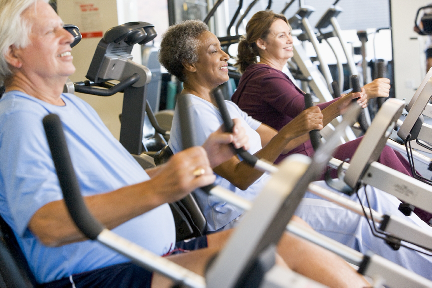.jpg?width=501&name=GettyImages-1138813719%20(1).jpg) If you’re looking to improve the overall happiness and well-being of your residents—and even yourself—try taking your offerings outside of the fitness center and straight into nature!
If you’re looking to improve the overall happiness and well-being of your residents—and even yourself—try taking your offerings outside of the fitness center and straight into nature!
Many of our NIFS fitness staff members schedule outdoor activities as a key component of their wellness programming, when and where weather permits. Some of the most popular open-air activities we have offered include walking groups, hiking trips, snowshoeing, yoga classes, mindfulness and meditation events, recreational sports, gardening, and outdoor socials. Exercise-related health benefits are already widely acknowledged, but did you know that the additional advantages of immersing oneself in nature may far surpass exercise alone?
Let the Sun Shine In!
Sunlight can help boost your Vitamin D levels, which is essential in calcium absorption to keep bones healthy and strong. Those who aren’t getting enough Vitamin D are much more likely to suffer from osteoporosis, heart disease, depression, weight gain, Alzheimer’s, and a whole catalog of cancers. In addition, getting sufficient sunlight can aid in preventing type-2 diabetes and some autoimmune disorders.
Get Active
Physical activity typically increases as we spend more time in natural environments, and the two together help activate the parasympathetic nervous system, which controls how the body responds when at rest. Not only does this provide a relaxing, calm feeling, but it also reduces resting blood pressure, strengthens immunity, and can help decrease the risk of developing chronic disease.
Just Being Outside Is Beneficial for Mental Health and Wellness
Not in the mood for a “workout”? That’s okay, too! You can still fight mental fatigue, tension, and stress by simply being in nature. A study conducted at the University of Michigan found that spending as little as 20 minutes either sitting or walking in nature was enough to significantly reduce levels of cortisol, a hormone commonly used as a stress marker. The greatest rate of reduction in cortisol levels was observed in those who spent between 20 and 30 minutes in green spaces.
Anxiety and depression, too, have been proven to be lessened by spending time in nature’s powerful restorative environments—so powerful, in fact, that researchers at Stanford University call time spent in nature a mental health prescription.
Mental health disorders can contribute to poor sleep, and poor sleep can equally contribute to mental health disorders. Not only can time spent in nature improve overall mental health, leading to better sleep, but it can also play a fundamental role in improving sleep patterns, leading to better mental health. Sleep patterns are intrinsically regulated by circadian rhythms—this is commonly referred to as the body’s internal clock—which is directly tied to the sun’s schedule. Spending too much time in the absence of natural light, or in the presence of artificial light, can alter a person’s circadian rhythm and disrupt sleep patterns. Lucky for us, this balance is easily restored by getting back to nature and spending time outside.
Are you taking advantage of all that nature has to offer and sharing it with everyone you know?
NIFS staff love helping create Active Adventures with the communities where we help do wellness better. Click below to see if outsourcing and having a vendor partner with you is a right fit!


 Why You Need to Drink Water
Why You Need to Drink Water
 Physical activity and exercise are two different terms that have similar concepts. Physical activity such as gardening, walking the dog, mowing the lawn, shopping, and taking the stairs gets your body moving. Exercise is a form of physical activity that is specifically planned, structured, and repetitive, such as strength training, yoga, or aerobics class. Both physical activity and exercise are great for seniors to keep up the daily activities they enjoy.
Physical activity and exercise are two different terms that have similar concepts. Physical activity such as gardening, walking the dog, mowing the lawn, shopping, and taking the stairs gets your body moving. Exercise is a form of physical activity that is specifically planned, structured, and repetitive, such as strength training, yoga, or aerobics class. Both physical activity and exercise are great for seniors to keep up the daily activities they enjoy.

 When I saw the Consumer Reports article a few weeks ago about them finding high levels of arsenic in rice, my first thought was, “surely they were wrong!” However, after researching it a little further, all of the evidence points to the sad truth that one of our cheapest, quickest, and most popular grains to eat and prepare may be dangerous.
When I saw the Consumer Reports article a few weeks ago about them finding high levels of arsenic in rice, my first thought was, “surely they were wrong!” However, after researching it a little further, all of the evidence points to the sad truth that one of our cheapest, quickest, and most popular grains to eat and prepare may be dangerous. Could your office be to blame for making you sick?
Could your office be to blame for making you sick?  Other than supposedly helping you go the bathroom, do you know the importance of adding fiber to your diet? Our bodies can’t digest it, so why eat it?
Other than supposedly helping you go the bathroom, do you know the importance of adding fiber to your diet? Our bodies can’t digest it, so why eat it? Summer has arrived along with barbeques, pool parties, ball games, and all those outdoor activities we enjoy this time of year. When those events are planned, you are most likely prepared to wear your hat and sunglasses and to apply sunscreen. But what about those everyday occurrences? Long walks from the car to the office, a bicycle commute to work, walk-at-work events, or simply enjoying your lunch outside expose the skin to harmful ultraviolet rays.
Summer has arrived along with barbeques, pool parties, ball games, and all those outdoor activities we enjoy this time of year. When those events are planned, you are most likely prepared to wear your hat and sunglasses and to apply sunscreen. But what about those everyday occurrences? Long walks from the car to the office, a bicycle commute to work, walk-at-work events, or simply enjoying your lunch outside expose the skin to harmful ultraviolet rays. I think walking, no matter what speed, is good for your health. Granted, you are going to burn more calories, get your heart rate up higher, and cover more ground if you pick up the pace while walking. Walking is low impact and doesn’t require equipment or a gym membership. All you need is a comfortable pair of shoes and possibly a walking partner.
I think walking, no matter what speed, is good for your health. Granted, you are going to burn more calories, get your heart rate up higher, and cover more ground if you pick up the pace while walking. Walking is low impact and doesn’t require equipment or a gym membership. All you need is a comfortable pair of shoes and possibly a walking partner. A recent AP/AOL poll of 1,000 Americans showed increased debt was directly related to increased perceived stress. Among those polled, individuals with the greatest debt exhibited the most physical and psychological health problems linked to their stress levels.
A recent AP/AOL poll of 1,000 Americans showed increased debt was directly related to increased perceived stress. Among those polled, individuals with the greatest debt exhibited the most physical and psychological health problems linked to their stress levels.